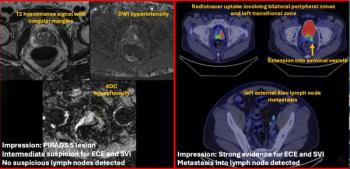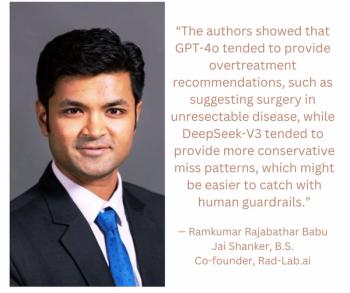New multinational research suggests that a mammography radiomic model may help predict the emergence of occult invasive breast cancer in women with confirmed ductal carcinoma in situ (DCIS).
For the retrospective study, recently published in Radiology, researchers assessed the mammography radiomic model based on data from 1,498 asymptomatic women (mean age of 59) with calcifications and biopsy-confirmed DCIS.1 The cohort included 696 women from the United States, 618 women based in the United Kingdom and 184 women from the Netherlands, according to the study.
For the prediction of occult invasive cancer, the study authors noted internal AUCs of 67.5 percent, 60.3 percent and 70.1 percent for the U.S., U.K. and Netherlands cohorts respectively. The U.S.-trained mammography radiomic model also achieved cross-validation AUCs of 60.4 percent in the U.K. cohort and 68.2 percent in the Netherlands cohort.1
In contrast, the study authors noted previous research that showed a 55 percent AUC for a clinical features model in predicting occult invasive cancer in patients with DCIS.2
“This internal coherence among diverse datasets enhances the credibility and applicability of radiomics for evaluating DCIS, supporting the robustness of our method across various health care settings,” wrote lead study author Rui Hou, Ph.D., who is affiliated with the School of Artificial Intelligence at the Beijing University of Posts and Telecommunications in Beijing, China, and colleagues.
Three Key Takeaways
- Radiomic modeling improves prediction of occult invasion over clinical features alone. Across U.S., U.K., and Netherlands cohorts, mammography radiomics achieved internal AUCs of 60 to 70 percent, outperforming a prior clinical-feature model that had a 55 percent AUC for identifying occult invasive cancer in DCIS.
- Cross-national performance supports generalizability.
A U.S.-trained model maintained meaningful accuracy when validated in external U.K. and Netherlands datasets (AUCs of 60.4 percent and 68.2 percent), suggesting robustness across diverse imaging practices and health-care settings.
- High NPV may aid active monitoring and reduce overtreatment. With an average NPV of 91.3 percent for ruling out invasive cancer and upstaging rates around 14 to 17 percent, the model shows promise for more confident presurgical risk stratification in women with biopsy-confirmed DCIS.
Use of the mammography radiomic model led to upstaging rates of 16.1 percent, 16.7 percent and 14.1 percent in the U.S., U.K. and Netherlands cohorts respectively, according to the researchers. In active monitoring, the study authors also demonstrated an average negative predictive value (NPV) of 91.3 percent for the mammography radiomic model in ruling out invasive breast cancer.1
“These collective findings hold promise for improving presurgical diagnosis and management strategies for DCIS,” added Hou and colleagues.
(Editor’s note: For related content, see “Can AI Assessment of Microcalcifications on Mammography Improve Differentiation of DCIS and Invasive Ductal Carcinoma?,” “Breast MRI-Based Radiomics May Reduce Overtreatment of DCIS” and “Predicting DCIS Upgrade to Invasive Breast Cancer: Can Contrast-Enhanced Ultrasound Have an Impact?”)
In regard to study limitations, the authors acknowledged potential variation in preferred biopsy needle gauge and sample number in different countries and the lack of data for certain receptor and grade features within the United Kingdom and Netherlands databases.
References
- Hou R, Grimm LJ, Marks JR, et al. Cross-national radiomics validation using mammography to predict occult invasion in ductal carcinoma in situ. Radiology. 2025 Nov;317(2):e243739. doi: 10.1148/radiol.243739.
2. Hou R, Grimm LJ, Mazurowski MA, et al. Prediction of upstaging in ductal carcinoma in situ based on mammographic radiomic features. Radiology. 2022;303(1):54-62.





























